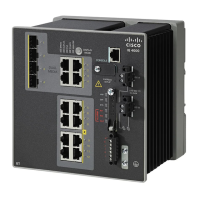34
Troubleshooting
Diagnosing Problems
Link Status
Verify that both sides have a link. A broken wire or a shutdown port can cause one side to show a link even though the
other side does not have a link.
A port LED that is on does not guarantee that the cable is functional. It might have encountered physical stress, causing
it to function at a marginal level. If the port LED does not turn on:
Connect the cable from the switch to a known good device.
Make sure that both ends of the cable are connected to the correct ports.
Verify that both devices have power.
Verify that you are using the correct cable type. See Cables and Adapters, page 38 for information.
Look for loose connections. Sometimes a cable appears to be seated but is not. Disconnect the cable, and then
reconnect it.
10/100 Port Connections
If a port appears to malfunction:
Verify the status of all ports by checking the LEDs. For more information, see Switch LEDs, page 33.
Verify the cable type. See Cable and Connectors, page 37.
SFP Module
Use only Cisco SFP modules. Each Cisco module has an internal serial EEPROM that is encoded with security information.
This encoding verifies that the module meets the requirements for the switch.
Inspect the SFP module. Exchange the suspect module with a known good module.
Verify that the module is supported on this platform. (The switch release notes on Cisco.com list the SFP modules
that the switch supports.)
Make sure that all fiber-optic connections are clean and securely connected.
Interface Settings
Verify that the interface is not disabled or powered off. If an interface is manually shut down on either side of the link, it
does not come up until you reenable the interface. If needed, reenable the interface.
Ping End Device
Ping from a laptop first, and then work your way back port by port, interface by interface, trunk by trunk, until you find
the source of the connectivity issue. Make sure that each switch can identify the end device MAC address in its
Content-Addressable Memory (CAM) table.
Spanning Tree Loops
STP loops can cause serious performance issues that look like port or interface problems.
A unidirectional link can cause loops. It occurs when the traffic sent by the switch is received by the neighbor, but the
traffic from the neighbor is not received by the switch. A broken cable, other cabling problems, or a port issue can cause
this one-way communication.
